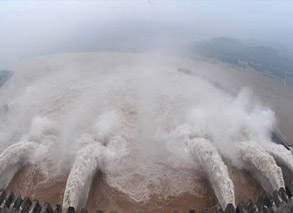India may abandon lunar mission after radio contact lost
2009-08-30 14:05 BJT
NEW DELHI, Aug. 29 (Xinhua) -- India may have to abandon its first unmanned lunar mission after the spacecraft, Chandrayaan-1, abruptly lost radio contact with its ground station in Bangalore Saturday, reported the Indo-Asian News Agency.
 |
| India's Polar Satellite Launch Vehicle (PSLV) C-11 blasts off carrying India's first unmanned moon mission Chandrayaan-1 from the Satish Dhawan space centre at Sriharikota, about 100 km (62 miles) north of the southern Indian city of Chennai October 22, 2008. (Xinhua/Reuters File Photo) |
The news service quoted S. Satish, director of the Indian Space Research Organization (ISRO), as saying that "attempts to re-establish contact have been futile" and "the mission is as good as lost".
Radio contacts with the luna craft was lost because of a "sudden failure of communication systems" of the craft, the report quoted scientists at ISRO's Deep Space Network (DSN) in Byalalu, about 40km from the space station in Bangalore, as saying,
Radio contacts through C-band, Ku-band and other bands were all lost, while the antenna on board Chandrayaan has stopped working, said the report.
However, the 520-kg luna craft will continue to orbit around the moon 200 km away and it may crash after sometime on the lunar surface, Satish said.
"The contact was lost at 1:30 a.m. IST (Indian Standard Time) (2000 GMT Friday) as the deep space network (DSN) at Byalalu, received the data from the lunar craft during the previous orbit up to 0:25 a.m. IST (1855 GMT Friday)," said ISRO in an earlier statement.
"The spacecraft has completed 312 days in orbit, making over 3,400 orbits around the moon and providing large volume of data from sophisticated sensors like terrain mapping camera, hyper-spectral imager, moon mineralogy mapper and so on, meeting most of the scientific objectives of the mission," the statement said.
Chandrayaan I was launched on Oct. 22, 2008 from Sriharikota space center, 90 km from Chennai, southern India, on board the polar satellite launch vehicle (PSLV).
Editor: Yang Jie | Source: Xinhua
 Mail
Mail Share
Share Print
Print


 Video
Video









 2009 China Central Television. All Rights Reserved
2009 China Central Television. All Rights Reserved